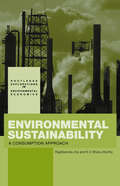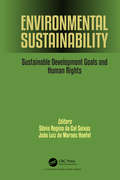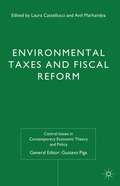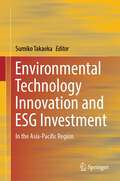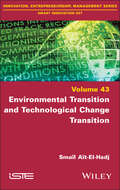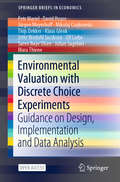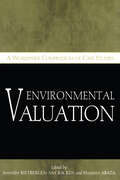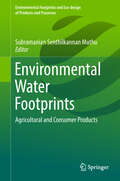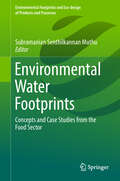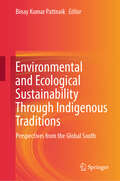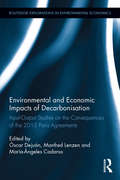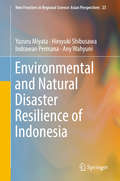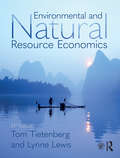- Table View
- List View
Environmental Sustainability: A Consumption Approach (Routledge Explorations in Environmental Economics #Vol. 5)
by Raghbendra Jha K.V. Bhanu MurthyWith globalization fast becoming an irreversible process, it is necessary to pay increased attention to the implications for environmental sustainability. However, the so-called environmental Kuznets curve (EKC) argument implies that rapid economic growth in many developing countries should be environmentally unsustainable. Environmental Sustainability addresses this dichotomy and articulates a notion of consumption sustainability that is both universal and pertains to the indefinite future. Additionally, it emphasizes the importance of addressing a broad spectrum of sources of environmental degradation and relates this measure to an index of economic achievement more complete than per capita income. As well as the EKC, authors Jha and Murthy also critique the Environmental Sustainability Index (ESI) and empirically substantiate the proposition that a certain type of development in the presently high-income countries is primarily responsible for global environmental degradation. Several policy conclusions for global environmental management are also advanced. Throughout, Jha and Murthy comprehensively evaluate existing approaches to environmental sustainability and critically review empirical studies of environmental degradation, and economic development, making this an invaluable source of information for those concerned with environmental economics and political economy.
Environmental Sustainability: An Evaluation of World Bank Group Support
by World BankThis evaluation assesses the Bank Group's support for environmental sustainability in both the public and private sectors over the past 15 years. It identifies several crucial constraints that need to be addressed, perhaps most importantly insufficient government commitment to environmental goals and weak institutional capacity to deal with them. But constraints within the Bank Group, including insufficient attention to longer-term sustainable development, must be reduced as well. The Bank Group needs improved systems in place--across the World Bank, IFC, and MIGA--to monitor environmental outcomes and to assess impacts. Better coordination among the three parts of the Bank Group is also among the key challenges.
Environmental Sustainability: Sustainable Development Goals and Human Rights
by Sônia Regina da Cal Seixas; João Luiz de Moraes HoefelUnited Nations 2030 Agenda for Sustainable Development 17 Goals blends the three dimensions of sustainable development: economic, social and environmental. They function as commitments to be met by governments, civil society and the private sector for a 2030 collaborative project. The five keywords to achieve it are: People, Planet, Prosperity, Peace, and Partnerships. Another reading is to link these precepts with the Universal Declaration of Human Rights because to obtain real development we need full realization of human rights. This book analyses Sustainable Development considering Sustainable Development Goals, their importance concerning human rights and its significance for a Sustainable Society.
Environmental Systems Studies
by Hidefumi ImuraThe environmental field is deep and wide. In the flood of information, how can people understand the underlying causes of what they hear about the environment from newspapers and television? This book was originally published in Japanese, with the aim of providing basic information about the ideas and methods to see and understand the interconnection between nature and human activities from a systematic point of view. The author subsequently prepared an English version of the same material for use as a textbook for the Global Environmental Leaders Program at Nagoya University, where he taught many students from Asia and Europe. The book covers diverse environmental issues such as climatic change, biodiversity preservation, energy conservation, and resource recycling. Readers can learn common methods of analysis and thinking to identify the core essence of economic and ecological interdependence, to look at problems from an overarching perspective, and to consider countermeasures to be taken.
Environmental Taxes and Fiscal Reform (Central Issues in Contemporary Economic Theory and Policy)
by Laura Castellucci Anil MarkandyaA review of the literature on environmental taxes, focusing on European experiences, and analysing how such taxes can contribute to green causes as well as reducing the tax burden from "ordinary" taxation. The authors examine the potential 'double dividend' from tax reform for helping the environment, reducing unemployment and encouraging growth.
Environmental Technology Fund Partners and E-Leather
by Aldo Sesia Vikram GandhiIt is 2014 and Environmental Technologies Fund (ETF) Partners, a U.K.-based venture capital firm, has an opportunity to invest in a privately-held U.K. company that manufactured engineered composition leather extracted from waste leather using an environmentally-friendly process. The end product looked, smelled and felt like natural leather. Scalable marketplace adoption of E-Leather's products looked promising, but was just that-promising. And the company's success would largely depend on management's ability to significantly improve the efficiency of its manufacturing operations. ETF needed to decide to invest in the company and, if so, at what valuation. In addition, ETF needed to decide the structure of the investment and how the firm would assess E-Leather's environmental impact.
Environmental Technology Innovation and ESG Investment: In the Asia-Pacific Region
by Sumiko TakaokaThis book focuses on environmental technology and financial markets of the Asia-Pacific region, which includes traditional and emerging innovative countries such as Japan, China, and South Korea. The research and its outcomes presented here are devoted to the nexus between innovation in environment-related technologies, finance, and environmental, social, and governance (ESG) issues. A promising means of achieving a sustainable society is to accelerate innovation in environmental technologies. Chapters of this book tackle some important issues. Using the data on environmental innovation creation and financial markets, the contributors identify three scopes in which ESG performance forms how investors evaluate corporate performance against climate-related risk in the Asia-Pacific capital markets (e.g., corporate bond and credit default swaps); how lenders allocate their credits according to carbon emissions in Japan; and what determines environmental technology creation and how it affects environmental improvement at a country-level. This book thus provides insights into the nexus between innovation in environment-related technologies, finance, and ESG.
Environmental Transition and Technological Change Transition
by Smaïl Aït-El-HadjFaced with the scale and intensity of the ecological crisis, environmental transition is underway, consisting of a first phase of technological mutation, aimed at replacing technologies harmful to the environment with those which have no destructive effects on the earth system and its equilibrium. This book examines the roots of the concept of environmental transition, identifying and characterizing the negative effects of technology on the environmental crisis. We will then identify the technological mutations that have the potential to contribute to environmental transition, and demonstrate how these changes are already forming part of a new emerging "technological system". We will conclude by addressing the question of the limits of technological responses to the environmental crisis, demonstrating the importance of the dimensional factors of human activity and weight of growth in this crisis, thus raising the issue of global reconsideration, with reference to the place and articulation of human activity in the Earth system.
Environmental Valuation with Discrete Choice Experiments in R: A Guide on Design, Implementation, and Data Analysis (The Economics of Non-Market Goods and Resources #17)
by Danny Campbell Petr Mariel Jürgen Meyerhoff Erlend Dancke Sandorf Ainhoa Vega-Bayo Rebecca BlevinsThis open access book offers advice and practical guidance for conducting discrete choice experiments (DCEs) in environmental valuation. It covers essential aspects of designing, implementing, and analysing choice experiments. Each chapter includes scripts and guidance, showcasing how to execute every step of a DCE using the free statistical computing and graphics software, R. This feature enhances accessibility and versatility for researchers in the field. While not providing strict guidelines, the book assists readers in steering clear of common mistakes encountered in applied work. With its insights and expertise, it equips researchers and practitioners to effectively navigate the complexities of DCEs.
Environmental Valuation with Discrete Choice Experiments: Guidance on Design, Implementation and Data Analysis (SpringerBriefs in Economics)
by Julian Sagebiel Petr Mariel David Hoyos Jürgen Meyerhoff Mikolaj Czajkowski Thijs Dekker Klaus Glenk Jette Bredahl Jacobsen Ulf Liebe Søren Bøye Olsen Mara ThieneThis open access book offers up-to-date advice and practical guidance on how to undertake a discrete choice experiment as a tool for environmental valuation. It discusses crucial issues in designing, implementing and analysing choice experiments. Compiled by leading experts in the field, the book promotes discrete choice analysis in environmental valuation through a more solid scientific basis for research practice. Instead of providing strict guidelines, the book helps readers avoid common mistakes often found in applied work. It is based on the collective reflections of the scientific network of researchers using discrete choice modelling in the field of environmental valuation (www.envecho.com).
Environmental Valuation: A Worldwide Compendium of Case Studies
by Jennifer Rietbergen-McCracken Hussein AbazaThis companion volume to Economic Instruments for Environmental Management presents essential information on the applications of economic valuation to environment and development. It draws on a three-year collaborative effort by research institutions around the world. Authoritative studies review the range of valuation methods used in developing economies, their purposes, the problems encountered and the quality of the results. Topics covered include the value of wildlife viewing, the conservation of rainforests, mangroves and coral reefs, supplying rural water, and controlling urban air pollution. The analysis reveals important methodological and contextual factors, highlighting key lessons and ways of strengthening future valuations. Written to be accessible to non-economists, the book provides source material for students and academics, and for policy-makers and professionals, using valuation methods to frame policy.
Environmental Water Footprints: Agricultural and Consumer Products (Environmental Footprints and Eco-design of Products and Processes)
by Subramanian Senthilkannan MuthuThis book uses case studies to highlight the environmental water footprints in the agricultural and livestock farming sector, and those of consumer products. Water conservation is a major element of every industry’s sustainability strategy.
Environmental Water Footprints: Concepts And Case Studies From The Food Sector (Environmental Footprints And Eco-design Of Products And Processes)
by Subramanian Senthilkannan MuthuThis book discusses the concept of water footprint and corporate water footprint, presenting case studies on a thermal power plant in India and on the food sector. Water conservation is a key element of industrial sustainability strategies.
Environmental and Agricultural Modelling:
by Martin Van Ittersum Floor M. BrouwerAgriculture increasingly faces the challenge of balancing its multiple functions in a sustainable way. Integrated assessment and modelling (IAM) can provide insight into the potential impacts of policy changes. However, concepts to address the wide range of issues and functions typical for agriculture are still scarce. Environmental and Agricultural Modelling reviews and presents our current understanding of integrated and working tools to assess and compute, ex-ante, alternative agricultural and environmental policy options, allowing: 1. Analysis at the full range of scales (farm to European Union and global) whilst focusing on the most important issues emerging at each scale; 2. Analysis of the environmental, economic and social contributions of agricultural systems towards sustainable rural development and rural viability; 3. Analysis of a broad range of issues and agents of change, such as climate change, environmental policies, rural development options, effects of an enlarging EU, international competition, and effects on developing countries.
Environmental and Ecological Sustainability Through Indigenous Traditions: Perspectives from the Global South
by Binay Kumar PattnaikThis book explores the environmental and ecological wisdom inherent in some of the indigenous traditions of traditional communities from developing societies like, Argentina, Brazil, India, Mexico, Sri Lanka, and Thailand. It throws light on how these discrete and unrecognized traditions have enabled communities to live in harmony with nature for ages. Despite the best efforts of the modern states through policy-making, intensive R&D for eco-friendly technologies and products, social and environmental impact assessment studies (SEIAS), and cost benefit analysis (CBA) of projects, environmental and ecological degradation continues, mostly in developing societies, which house large number of traditional communities. This book explores their traditions consisting of world views or cosmologies, eco-savvy-customs, indigenous knowledge systems involving community-based occupations and practices, skills and crafts, and so on. This book shows that when interpreted in consonance with scientific environmentalism, these traditions reveal their inbuilt environmental wisdom, mirroring sacredness of nature that have instilled built-in conservation practices, are key to sustainability.The conception of indigenous traditions that subsume environmental and ecological sustainability as well as cultural identity is studied in the book, from the vantage of multi-disciplinary perspectives. This book reflects two streams of thought : (i) stream of social anthropology, arguing for the inbuilt strength of indigenous traditions, that necessitate empathetic understanding with their own rights for recognition and survival, and (ii) stream of indigenous knowledge systems being technically effective only necessitate validation and certification by modern scientific knowledge system for wider use. The book is of great use to policy-makers and non-government players, in addition to researchers and academicians working in the area of sustainable development and indigenous / traditional communities.
Environmental and Economic Impacts of Decarbonization: Input-Output Studies on the Consequences of the 2015 Paris Agreements (Routledge Explorations in Environmental Economics)
by Manfred Lenzen Óscar Dejuán Maria Ángeles CadarsoOn December 12th, 2015, at the United Nations Conference on Climate Change held in Paris, 195 countries adopted the first-ever universal and legally binding climate deal. They agreed to decarbonize the economy in order to hold the increase in the global average temperature to well below 2ºC relative to the preindustrial levels. Although each country is free to design its own strategy on mitigation and adaptation, it will be bound to such strategy and is supposed to implement the bulk of the adjustments by 2050. Many questions arise from the Paris Agreement that points to a second Industrial Revolution. What are the required changes in the structure of production and in the patterns of consumption? What will be their impacts on emissions, employment and international trade? This book answers these questions from a variety of input-output models able to compute the impacts on specific sectors and regions. This volume has 17 chapters written by 52 co-authors who are specialists in input-output analysis and environmental sustainability. They come from 24 universities, research centers and international agencies all over the world, sharing their commitments to explain important and complex ideas in a way that is understandable to the non-experts and experts alike. Environmental and Economic Impacts of Decarbonization is a very important read for those who study environmental economics, climate change and ecological economics.
Environmental and Energy Policy and the Economy: Volume 1 (NBER-Environmental and Energy Policy and the Economy #1)
by The University of Chicago PressThis volume presents six new papers on environmental/energy economics and policy. Robert Stavins evaluates carbon taxes versus a cap-and-trade mechanism for reducing greenhouse-gas emissions, arguing that specific design features of either instrument can be more consequential than the choice of instrument itself. Lucas Davis and James Sallee show that the exemption of electric vehicles from the gasoline tax is likely to be efficient as long as gasoline prices remain below social marginal costs, even though it results in lower tax revenue. Caroline Flammer analyzes the rapidly growing market for green bonds and highlights the importance of third-party certification to the financial and environmental performance of publically traded companies. Antonio Bento, Mark Jacobsen, Christopher Knittel, and Arthur van Benthem develop a general framework for evaluating the costs and benefits of fuel economy standards and use it to account for the differences between several recent studies of changes in these standards. Nicholas Muller estimates a measure of output in the U.S. economy over the last 60 years that accounts for air pollution damages, and shows that pollution effects are sizable, affect growth rates, and have diminished appreciably over time. Finally, Marc Hafstead and Roberton Williams illustrate methods of accounting for employment effects when evaluating the costs and benefits of environmental regulations.
Environmental and Energy Policy and the Economy: Volume 2 (NBER-Environmental and Energy Policy and the Economy #2)
by The University of Chicago PressThis volume presents six new papers on environmental and energy economics and related policy issues. Robert Pindyck provides a systematic overview of what is known, and remains unknown, about climate change, along with the implications of uncertainty for climate policy. Shaikh Eskander, Sam Fankhauser, and Joana Setzer offer insights from a comprehensive data set on climate change legislation and litigation across all countries of the world over the past thirty years. Adele Morris, Noah Kaufman, and Siddhi Doshi shine a light on how expected trends in the coal industry will create significant challenges for the local public finance of coal-reliant communities. Joseph Aldy and his collaborators analyze the treatment of co-benefits in benefit-cost analyses of federal clean air regulations. Tatyana Deryugina and her co-authors report on the geographic and socioeconomic heterogeneity in the benefits of reducing particulate matter air pollution. Finally, Oliver Browne, Ludovica Gazze, and Michael Greenstone use detailed data on residential water consumption to evaluate the relative impacts of conservation policies based on prices, restrictions, and public persuasion.
Environmental and Energy Policy and the Economy: Volume 4 (NBER-Environmental and Energy Policy and the Economy #4)
by The University of Chicago PressRigorous, careful, and nonpartisan research with a high policy impact on environmental and energy economics. Environmental and Energy Policy and the Economy focuses on the effective and efficient management of environmental and energy challenges. Research papers offer new evidence on the intended and unintended consequences, the market and nonmarket effects, and the incentive and distributional impacts of policy initiatives and market developments. This volume presents six new papers on environmental and energy economics and policy. Gilbert Metcalf examines the distributional impacts of substituting a vehicle miles-traveled tax for the existing federal excise tax in the United States. David Weisbach, Samuel Kortum, Michael Wang, and Yujia Yao consider solutions to the leakage problem of climate policy with differential tax policies on the supply and demand for fossil fuels and on domestic production and consumption. Danae Hernandez-Cortes, Kyle Meng, and Paige Weber quantify and decompose recent trends in air pollution disparities in the US electricity sector. Severin Borenstein and Ryan Kellogg provide a comparative analysis of different incentive-based mechanisms to reduce emissions in the electricity sector on a path to zero emissions. Sarah Anderson, Andrew Plantinga, and Matthew Wibbenmeyer document distributional differences in the allocation of US wildfire prevention projects. Finally, Mark Curtis and Ioana Marinescu provide new evidence on the quality and quantity of emerging “green” jobs in the United States.
Environmental and Food Safety and Security for South-East Europe and Ukraine
by Ksenija VitaleThis book covers important aspects of the field of food security and safety, ranging from fundamental production, through advanced water treatment technologies and detection of novel pollutants, to management and policy making. The discussion strives to develop an integrated approach to solving the associated problems by simultaneously considering sociological, ecological and economic aspects. Special focus is on the environmental management systems that should be integrated in the processes of environmental risk assessment. Also addressed are other technologies applied in the service of detecting, preventing and monitoring possible threats to food security and safety. With its variety of subjects, this volume can serve both as a textbook for advanced studies and as a useful reference source for professionals.
Environmental and Human Impact of Buildings: An Energetics Perspective (Springer Tracts in Civil Engineering)
by Ligia Moga Teodora M. ȘoimoșanFeaturing research on topics such as low energy buildings' concepts, construction materials and technology, hybrid energy systems, energy balance, and wellbeing, this book meets the expectations of academicians, specialists and researchers in the field, along with the scholars seeking coverage on buildings, environmental and human impact. It presents an integrated approach to the buildings' energetic aspects, from the perspective of environmental impact, together with the indoor wellbeing. In this respect, the chapters include state of the art, case studies, as well as research results that validate the raised hypotheses. The book integrates topics related to buildings' performance, approached by researchers with different backgrounds within the civil engineering domain, i.e. achieved energetics performances, obstacles, restrictions and limitations issues within design and optimization processes, including the new perspectives in the buildings & energy sector.
Environmental and Human Security in the Arctic
by Gunhild Hoogensen Gjørv Dawn R. Bazely Marina Goloviznina Andrew J. TanentzapThis is the first comprehensive exploration of why human security is relevant to the Arctic and what achieving it can mean, covering the areas of health of the environment, identity of peoples, supply of traditional foods, community health, economic opportunities, and political stability. The traditional definition of security has already been actively employed in the Arctic region for decades, particularly in relation to natural resource sovereignty issues, but how and why should the human aspect be introduced? What can this region teach us about human security in the wider world? The book reviews the potential threats to security, putting them in an analytical framework and indicating a clear path for solutions.Contributions come from natural, social and humanities scientists, hailing from Canada, Russia, Finland and Norway. Environmental Change and Human Security in the Arctic is an essential resource for policy-makers, community groups, researchers and students working in the field of human security, particularly for those in the Arctic regions.
Environmental and Natural Disaster Resilience of Indonesia (New Frontiers in Regional Science: Asian Perspectives #23)
by Hiroyuki Shibusawa Yuzuru Miyata Indrawan Permana Any WahyuniThis study aims at analyzing the resilience of Indonesia from two aspects: one is was natural disaster and the other is environmental protection. Therefore the study comprises two parts. The first aims at analyzing Palangkaraya City in Central Kalimantan Province by constructing apartial and a general equilibrium models; hence the existence of illegal settlements can be explained systematically. The models demonstrates a new attempt in city analysis by introducing the expected flood damage rate on households’ assets. Furthermore, a numerical simulation shows a new finding, namely, that the bid rent by representative low-income households in flood-prone areas canreceive higher than the bid rent by the representative high-income households. The second part examines (1) the provision of public goods such as road construction on the Maros–Watampone Road, and (2) the urban economics of Makassar City. In this second part, the analytic hierarchy process is applied to design efficiency with respect to selecting the best type of road construction in a conservation area. As a result, the elevated bridge is determined to be the most suitable type of construction, followed by cut-and-fill and the tunnel system. The second research approach uses a computable general equilibrium (CGE) model that adds environmental objectives to urban economic objectives in Makassar City. The model examines the impact of the carbon tax based on the 2006 input–output table for Makassar City. The results of all simulations of the CGE model indicates that a carbon tax can reduce the volume of CO2 emissions by 8 %.
Environmental and Natural Resource Economics
by Kentaka ArugaThis textbook discusses environmental and natural resource economics. It presents foundational knowledge for applying economics to understand environmental economics as well as for managing environmental problems and optimizing the level of natural resource extraction. Environmental and Natural Resource Economics bridges knowledge between the major natural environmental issues and which economic policies could be applied for reducing human impacts on such issues. It is distinctive from other environmental economics textbooks by covering not only basic concepts introduced in environmental economics but also explains economic models developed in resource economics for optimizing the use of non-renewable and renewable resources for sustainability. This textbook will help students understand how to apply economics for utilizing policies to mitigate environmental issues caused from the output side of economic activities such as emitting pollutants or generating wastes and those derived from the input side such as natural resource extractions.
Environmental and Natural Resource Economics
by Lynne Lewis Thomas H. TietenbergEnvironmental and Natural Resource Economics is the best-selling text for natural resource economics and environmental economics courses, offering a policy-oriented approach and introducing economic theory and empirical work from the field. Students will leave the course with a global perspective of both environmental and natural resource economics and how they interact. Complemented by a number of case studies showing how underlying economic principles provided the foundation for specific environmental and resource policies, this key text highlights what can be learned from the actual experience. This new, 11th edition includes updated data, a number of new studies and brings a more international focus to the subject. Key features include: Extensive coverage of the major issues including climate change, air and water pollution, sustainable development, and environmental justice. Dedicated chapters on a full range of resources including water, land, forests, fisheries, and recyclables. Introductions to the theory and method of environmental economics including externalities, benefit-cost analysis, valuation methods, and ecosystem goods and services. Boxed ‘Examples’ and ‘Debates’ throughout the text which highlight global examples and major talking points. The text is fully supported with end-of-chapter summaries, discussion questions, and self-test exercises in the book and multiple-choice questions, simulations, references, slides, and an instructor’s manual on the Companion Website.
